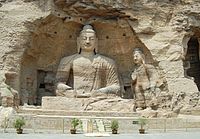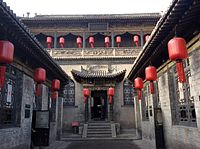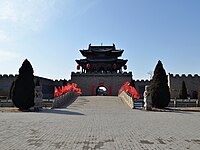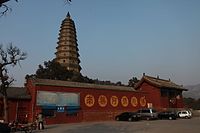
Shanxi is a landlocked province of the People's Republic of China and is part of the North China region. The capital and largest city of the province is Taiyuan, while its next most populated prefecture-level cities are Changzhi and Datong. Its one-character abbreviation is "晋", after the state of Jin that existed there during the Spring and Autumn period.

Taiyuan is the capital and largest city of Shanxi Province, People's Republic of China. Taiyuan is the political, economic, cultural and international exchange center of Shanxi Province. It is an industrial base focusing on energy and heavy chemicals. Throughout its long history, Taiyuan was the capital or provisional capital of many dynasties in China, hence the name Lóngchéng.

Tang dynasty art refers to Chinese art created during the Tang dynasty (618–907). The period saw significant advancements in arts such as painting, sculpture, calligraphy, music, dance, and literature. During the Tang dynasty, the capital city Chang'an, was the most populous city in the known world, and the era is generally regarded by historians as a high point in Chinese civilization and a golden age of Chinese literature and art.

Datong is a prefecture-level city in northern Shanxi Province in the People's Republic of China. It is located in the Datong Basin at an elevation of 1,040 metres (3,410 ft) and borders Inner Mongolia to the north and west and Hebei to the east. As of the 2020 census, it had a population of 3,105,591 of whom 1,790,452 lived in the built-up area made of the 2 out 4 urban districts of Pingcheng and Yungang as Yunzhou and Xinrong are not conurbated yet.

The Longmen Grottoes or Longmen Caves are some of the finest examples of Chinese Buddhist art. Housing tens of thousands of statues of Shakyamuni Buddha and his disciples, they are located 12 kilometres (7.5 mi) south of present-day Luoyang in Henan province, China. The images, many once painted, were carved as outside rock reliefs and inside artificial caves excavated from the limestone cliffs of the Xiangshan (香山) and Longmenshan, running east and west. The Yi River flows northward between them and the area used to be called Yique. The alternative name of "Dragon's Gate Grottoes" derives from the resemblance of the two hills that check the flow of the Yi River to the typical "Chinese gate towers" that once marked the entrance to Luoyang from the south. There are as many as 100,000 statues within the 2,345 caves, ranging from 1 inch (25 mm) to 57 feet (17 m) in height. The area also contains nearly 2,500 stelae and inscriptions, hence the name "Forest of Ancient Stelae", as well as over sixty Buddhist pagodas. Situated in a scenic natural environment, the caves were dug from a 1 kilometre (0.62 mi) stretch of cliff running along both banks of the river. 30% date from the Northern Wei and 60% from the Tang dynasty, caves from other periods accounting for less than 10% of the total. Starting with the Northern Wei dynasty in 493 AD, patrons and donors included emperors, Wu Zetian, members of the royal family, other rich families, generals, and religious groups.
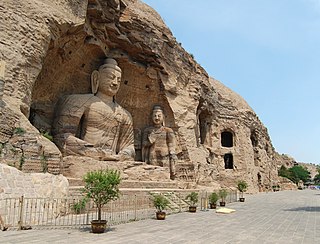
The Yungang Grottoes, formerly the Wuzhoushan Grottoes, are ancient Chinese Buddhist temple grottoes built during the Northern Wei dynasty near the city of Datong, then called Pingcheng, in the province of Shanxi. They are excellent examples of rock-cut architecture and one of the three most famous ancient Buddhist sculptural sites of China. The others are Longmen and Mogao.

Mount Wutai, also known by its Chinese name Wutaishan and as Mount Qingliang, is a sacred Buddhist site at the headwaters of the Qingshui in Shanxi Province, China. Its central area is surrounded by a cluster of flat-topped peaks or mesas roughly corresponding to the cardinal directions. The north peak is the highest and is also the highest point in North China.
Dayun Expressway is the largest expressway structure in China's Shanxi province.

Chinese architecture is the embodiment of an architectural style that has developed over millennia in China and has influenced architecture throughout East Asia. Since its emergence during the early ancient era, the structural principles of its architecture have remained largely unchanged. The main changes involved diverse decorative details. Starting with the Tang dynasty, Chinese architecture has had a major influence on the architectural styles of neighbouring East Asian countries such as Japan, Korea, Vietnam, and Mongolia in addition to minor influences on the architecture of Southeast and South Asia including the countries of Malaysia, Singapore, Indonesia, Sri Lanka, Thailand, Laos, Cambodia and the Philippines.

In Mahayana and Vajrayana Buddhism, the Five Tathāgatas or Five Wisdom Tathāgatas, the Five Great Buddhas, the Five Dhyani Buddhas and the Five Jinas, are five Buddhas which are often venerated together. Various sources provide different names for these Buddhas, though the most common today are: Akshobhya, Ratnasambhava, Vairocana, Amitābha, and Amoghasiddhi.
Shanxi merchants, also known as Jin merchants, were the group of merchants from Shanxi province, China. Jin is an abbreviated name of Shanxi. Even though the history of noticeable Shanxi merchants can be dated back to as early as the Spring and Autumn Period, more than 2000 years ago, Shanxi merchants became prominent during the Ming and Qing dynasties, and their dominant influence in Chinese commerce, within the nation and with neighboring Mongolia, Russia, and Japan, lasted for more than 500 years.

Foguang Temple is a Buddhist temple located five kilometres from Doucun, Wutai County, Shanxi Province of China. The major hall of the temple is the Great East Hall, built in 857 AD, during the Tang dynasty (618–907). According to architectural records, it is the third earliest preserved timber structure in China. It was rediscovered by the 20th-century architectural historian Liang Sicheng (1901–1972) in 1937, while an older hall at Nanchan Temple was discovered by the same team a year later. The temple also contains another significant hall dating from 1137 called the Manjusri Hall. In addition, the second oldest existing pagoda in China, dating from the 6th century, is located in the temple grounds. Today the temple is part of a UNESCO World Heritage site and is undergoing restoration.

Nanchan Temple is a Buddhist temple located near the town of Doucun on Mount Wutai, Shanxi, China. Nanchan Temple was built in 782 during China's Tang dynasty, and its Great Buddha Hall is currently China's oldest preserved timber building extant, as wooden buildings are often prone to fire and various destruction. Not only is Nanchan Temple an important architectural site, but it also contains an original set of artistically important Tang sculptures dating from the period of its construction. Seventeen sculptures share the hall's interior space with a small stone pagoda.

Zhenguo Temple is a Buddhist temple located 10 km from Pingyao in the village of Hadongcun, in Shanxi Province, China. The temple's oldest hall, the Wanfo Hall, was built in 963 during the Northern Han dynasty, and is notable for featuring very large brackets that hold up the roof and flying eaves. The sculptures inside the hall are among the only examples of 10th century Buddhist sculpture in China.

Taigu is a district of Shanxi province, China under the administration of Jinzhong City. It is administratively into three town-level entities, and six township-level entities. Taigu is linked to nearby Yuci in Jinzhong by rail via the Taigu Railway Stop.
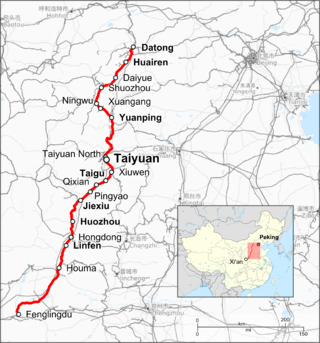
The Datong–Puzhou or Tongpu railway, is a major trunkline railroad in northern China, and the main axial railway of Shanxi Province. The railway is located entirely within Shanxi and diagonally bisects the province from Datong in the northeast to Fenglingdu, near the village of Puzhou, in the southwest corner. The line is named after Datong and Puzhou, and has a total length of 865 km (537 mi). The line is often referred to by its northern and southern halves with Taiyuan, the provincial capital as the midpoint. Southern Tongpu railway from Taiyuan to Fenglingdu is 513 km (319 mi) in length and was built from 1933 to 1935. The Northern Tongpu railway, from Datong to Taiyuan is 351 km (218 mi) in length and was built from 1933 to 1940. Major cities and towns along route include Datong, Huairen, Shuozhou, Ningwu, Yuanping, Xinzhou, Taiyuan, Yuci, Taigu, Qi County, Pingyao, Huozhou, Hongdong, Linfen, Houma and Fenglingdu.

The Xiantong Temple is a Buddhist temple located in Taihuai Town of Wutai County, Shanxi, China. The temple covers a total area of about 80,000 square metres (860,000 sq ft), it preserves the basic architectural pattern of the Ming and Qing dynasties (1368–1912). The temple has over 400 buildings and the seven main halls along the central axis are the Guanyin Hall, Great Manjusri Hall, Great Buddha Hall, Amitaba Hall, Qianbo Hall, Copper Hall and Buddhist Texts Library. Mount Wutai has 47 Buddhist temples, it is the largest Buddhist complex in China, Xiantong Temple is the largest one with the longest history.

Tayuan Temple is located in the central area of Taihuai town in Mount Wutai, Shanxi Province, China. Tayuan Temple was originally a stupa of Xiantong Temple. The stupa, named the Great White Pagoda, was constructed in the 6th year of DaDe reign of the Yuan dynasty. In the 5th year of Yongle reign of the Ming Dynasty (1407AD), it was expanded to a temple and got its name as Tayuan Temple. It is listed in the Major Historical and Cultural Sites Protected in Shanxi Province, China.

Huayan Temple or Huayan Monastery is a Buddhist temple located in Datong, Shanxi, China.
